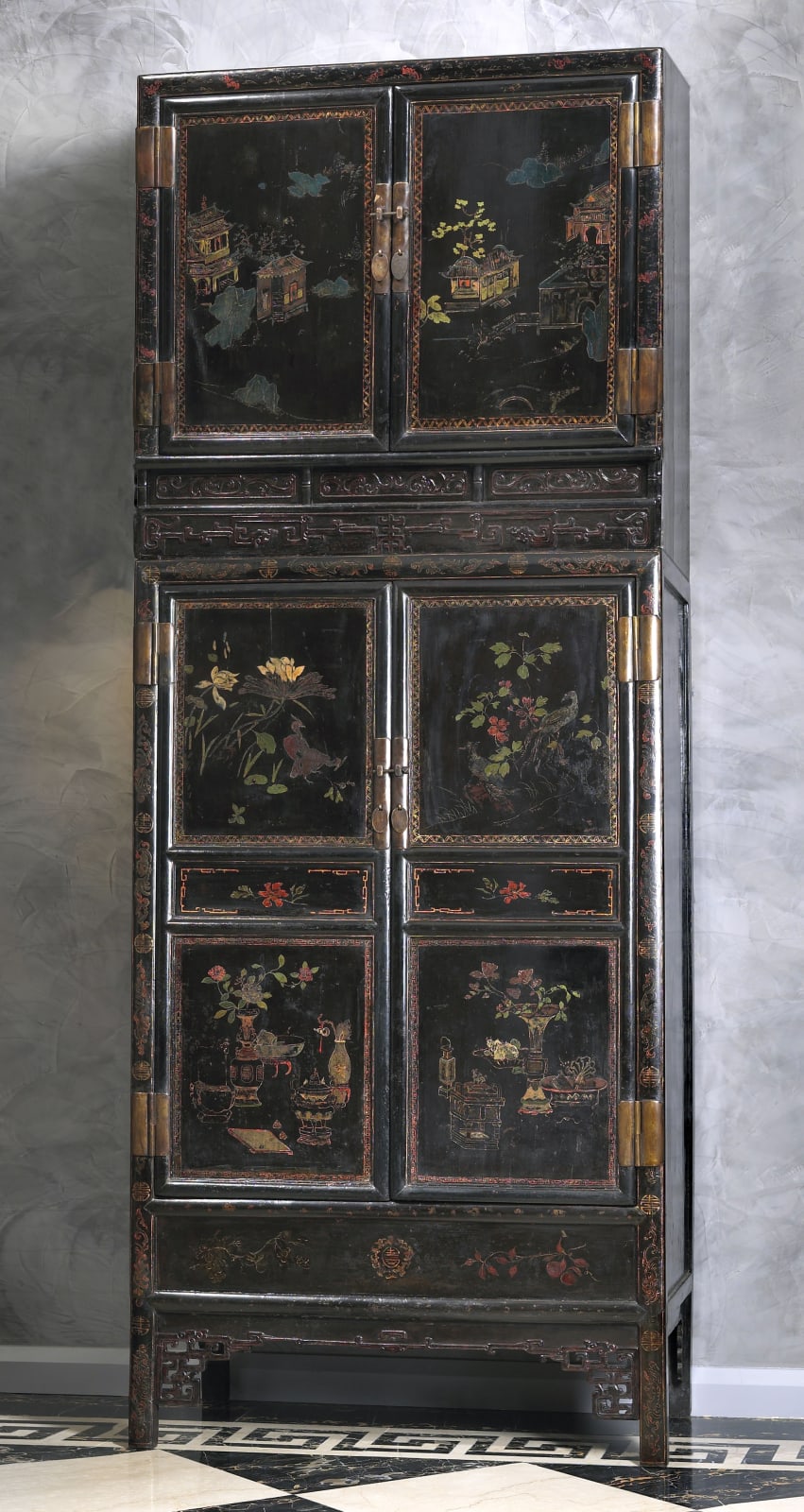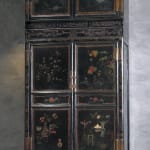Unknown
A very important pair of early seventeenth century late Kangxi dynasty Imperial Chinese polychrome and gilt-decorated black lacquer cabinets and hat chests (sijian gui), each square corner compound cupboard in two sections with a removable 'hat box' upper compartment, with surface-mounted plain rectangular bronze hinges and conforming backplates, the upper compartment with two doors decorated with island pavilions on a lake, the one on the right surrounded by a wall, the lowers cabinet doors each composed of two main and one smaller dividing panel featuring flowers, ducks amid reeds and a flowering tree, a vase of flowers, a miniature chest and various utensils, with further painted flowers below, the upper compartment doors opening to reveal a single shelf, the lower two doors opening to reveal a shaped gilt edged frieze above two shelves, the upper shelf with two drawers, both interiors in a reddish brown lacquer, the frame with scrolling trails and circular shou characters above a straight apron and pierced spandrels on short rectangular legs
Chinese, early seventeenth century late Kangxi Dynasty (reigned 1662-1722)
Height 274 cm, width 110 cm, depth 55 cm. each.
Such impressive large-scale cabinets as these belong to a group known as sijian gui or four-part wardrobes and would have been made for one of the Imperial palaces. A similar example painted with pavilions, figures and boats in a riverscape in gilt on a black lacquer ground is in the National Palace Museum, Beijing, (illustrated in Zhu Jiajin, "The Complete Collection of the Treasures of the Palace Museum: Ming and Qing Dynasty Furniture", 2002, no. 175). Another example, painted with ladies engaged in literati pursuits and children playing, is now in the Minneapolis Institute of Arts, (illustrated in Robert Jacobsen and Nicholas Grindley, "Classical Chinese Furniture", 1999, no. 48). One can also cite a fine pair of sixteenth century Ming dynasty cabinets (290.2 x 143.5 x 66.8 cm) painted with red and gold decoration on black lacquer, which are housed at the Philadelphia Museum of Art as well as another red lacquer pair in the same collection. In addition one can view a seventeenth century pair of cabinets in red lacquer with cloisonné enamel mounts in the Norton Museum of Art, Palm Beach (illustrated in John R. Finlay, "The Chinese Collection, Selected Works from the Norton Museum of Art", 2003, no. 109).
Nearly all the monumental cabinets of this type in Western public and private collections were removed from the Imperial palaces in Beijing during the early 1900's. For instance a pair of Ming dynasty cabinets, lacquered with gilt decoration on a reddish-brown ground (329.6 x 158.7 x 69.8 cm) was purchased in 1918 by George Raymond (of the Goodrich Tyre Company), who was involved in the American Expeditionary Force, (illustrated in the Lark E. Mason, "Examples of Ming Furniture in American Collections formed prior to 1980" in "Chinese Furniture. Selected Articles From Orientations 1984-1994", pp. 130-137, pl. 2). A few examples however can still be found in their original context within the various palaces and halls of the Forbidden City (now the collection of the Palace Museum). For instance a similar type of cabinet can just be seen in a photograph of the Yangxin Dian Hall of Mental Cultivation, the personal residence and executive offices of the Qianlong emperor (illustrated in Ho and Bennett, "Splendours of China's Forbidden City, The Glorious Reign of Emperor Qianlong", 2004, pl. 283). It appears that there was no correlation between the function of the hall and the positioning of such cabinets nor the type of material used in their decoration. In some cases multiple hat chests were stacked one upon another, sometimes reaching over six metres in height as evident in a photograph of the Kunning Gong, 'Mansion of Earthly Tranquillity' (illustrated ibid. pl. 141). There were also a number of smaller cabinets, which lacked the upper 'hat chests' in the Imperial palaces, some of which can still be seen in the Palace Museum, Beijing.



